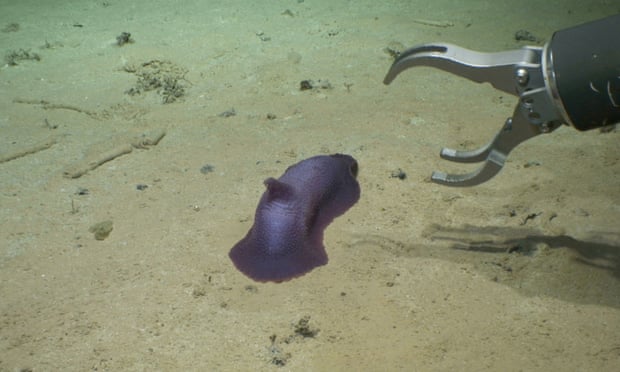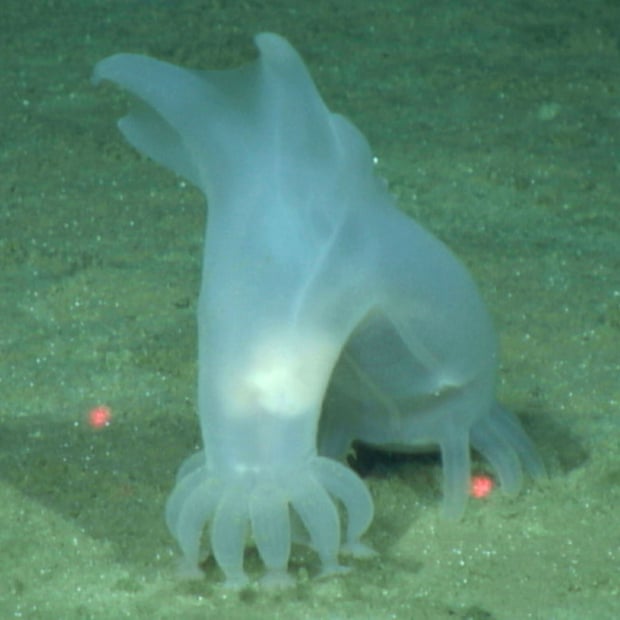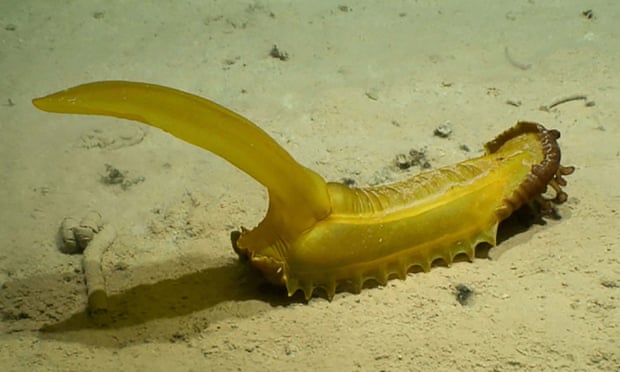Natural History Museum scientists seek to unlock mysteries of deep sea but some fear activity will disturb diversity of the depths
Newly discovered deep sea species, the gummy squirrel (Psychropotes longicauda). Photograph: Courtesy of DeepCCZ expedition/NOAA
Helena Horton
Helena Horton
Environment reporter
Tue 26 Jul 2022
Scientists have found more than 30 potentially new species living at the bottom of the sea.
Researchers from the UK’s Natural History Museum used a remotely operated vehicle to collect specimens from the abyssal plains of the Clarion-Clipperton Zone in the central Pacific. Previously, creatures from this area had been studied only from photographs.
The study, published in the journal Zookeys, found there is a high species diversity of larger organisms in the abyss. Of the 55 specimens recovered, 48 were of different species.
Scientists have found more than 30 potentially new species living at the bottom of the sea.
Researchers from the UK’s Natural History Museum used a remotely operated vehicle to collect specimens from the abyssal plains of the Clarion-Clipperton Zone in the central Pacific. Previously, creatures from this area had been studied only from photographs.
The study, published in the journal Zookeys, found there is a high species diversity of larger organisms in the abyss. Of the 55 specimens recovered, 48 were of different species.

Psychropotes verrucicaudatus, newly discovered using robot technology.
Photograph: Courtesy of DeepCCZ expedition/Gordon & Betty Moore Foundation & NOAA
The animals found include segmented worms, invertebrates from the same family as centipedes, marine animals from the same family as jellyfish, and different types of coral.
Thirty-six specimens were found at more than 4,800 metres deep, two were collected on a seamount slope at 4,125 metres, and 17 were found at between 3,095 and 3,562 metres deep.
The findings have potentially important implications for deep-sea mining, as humans become more interested in exploiting minerals from the seabed, because it seems the activity has the potential to disturb many creatures.
The animals found include segmented worms, invertebrates from the same family as centipedes, marine animals from the same family as jellyfish, and different types of coral.
Thirty-six specimens were found at more than 4,800 metres deep, two were collected on a seamount slope at 4,125 metres, and 17 were found at between 3,095 and 3,562 metres deep.
The findings have potentially important implications for deep-sea mining, as humans become more interested in exploiting minerals from the seabed, because it seems the activity has the potential to disturb many creatures.

Peniagone vitrea in situ.
Photograph: Courtesy of DeepCCZ expedition/Gordon & Betty Moore Foundation & NOAA
The study’s lead author, Dr Guadalupe Bribiesca-Contreras, of the Natural History Museum, said: “This research is important not only due to the number of potentially new species discovered, but because these megafauna specimens have previously only been studied from seabed images. Without the specimens and the DNA data they hold, we cannot properly identify the animals and understand how many different species there are.”
Dr Adrian Glover, who leads the Natural History Museum’s deep-sea research group, said: “We know that millimetre-sized animals called macrofauna are extremely biodiverse in the abyss. However, we have never really had much information on the larger animals we call megafauna, as so few samples have been collected. This study is the first to suggest that diversity may be very high in these groups as well.”
The study’s lead author, Dr Guadalupe Bribiesca-Contreras, of the Natural History Museum, said: “This research is important not only due to the number of potentially new species discovered, but because these megafauna specimens have previously only been studied from seabed images. Without the specimens and the DNA data they hold, we cannot properly identify the animals and understand how many different species there are.”
Dr Adrian Glover, who leads the Natural History Museum’s deep-sea research group, said: “We know that millimetre-sized animals called macrofauna are extremely biodiverse in the abyss. However, we have never really had much information on the larger animals we call megafauna, as so few samples have been collected. This study is the first to suggest that diversity may be very high in these groups as well.”


No comments:
Post a Comment